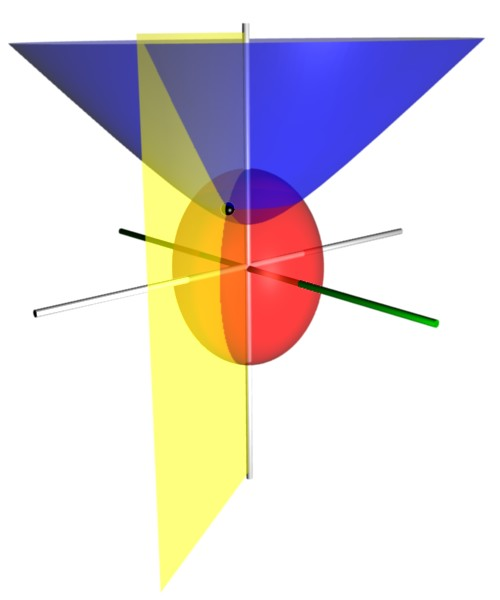
Prolate spheroidal coordinates are a three-dimensional
orthogonal coordinate system that results from rotating the two-dimensional
elliptic coordinate system about the focal axis of the ellipse, i.e., the symmetry axis on which the foci are located. Rotation about the other axis produces
oblate spheroidal coordinates
Oblate spheroidal coordinates are a three-dimensional orthogonal coordinate system that results from rotating the two-dimensional elliptic coordinate system about the non-focal axis of the ellipse, i.e., the symmetry axis that separates the fo ...
. Prolate spheroidal coordinates can also be considered as a
limiting case of
ellipsoidal coordinates
Ellipsoidal coordinates are a three-dimensional orthogonal coordinate system (\lambda, \mu, \nu) that generalizes the two-dimensional elliptic coordinate system. Unlike most three-dimensional orthogonal coordinate systems that feature quadratic ...
in which the two smallest
principal axes are equal in length.
Prolate spheroidal coordinates can be used to solve various
partial differential equations in which the boundary conditions match its symmetry and shape, such as solving for a field produced by two centers, which are taken as the foci on the ''z''-axis. One example is solving for the
wavefunction
A wave function in quantum physics is a mathematical description of the quantum state of an isolated quantum system. The wave function is a complex-valued probability amplitude, and the probabilities for the possible results of measurements ...
of an
electron
The electron ( or ) is a subatomic particle with a negative one elementary electric charge. Electrons belong to the first generation of the lepton particle family,
and are generally thought to be elementary particles because they have no ...
moving in the
electromagnetic field of two positively charged
nuclei, as in the
hydrogen molecular ion
The dihydrogen cation or hydrogen molecular ion is a cation (positive ion) with formula . It consists of two hydrogen nuclei (protons) sharing a single electron. It is the simplest molecular ion.
The ion can be formed from the ionization of a n ...
, H
2+. Another example is solving for the
electric field generated by two small
electrode
An electrode is an electrical conductor used to make contact with a nonmetallic part of a circuit (e.g. a semiconductor, an electrolyte, a vacuum or air). Electrodes are essential parts of batteries that can consist of a variety of materials d ...
tips. Other limiting cases include areas generated by a line segment (''μ'' = 0) or a line with a missing segment (ν=0). The electronic structure of general diatomic molecules with many electrons can also be solved to excellent precision in the prolate spheroidal coordinate system.
Definition

The most common definition of prolate spheroidal coordinates
is
:
:
:
where
is a nonnegative real number and
 Prolate spheroidal coordinates are a three-dimensional orthogonal coordinate system that results from rotating the two-dimensional elliptic coordinate system about the focal axis of the ellipse, i.e., the symmetry axis on which the foci are located. Rotation about the other axis produces
Prolate spheroidal coordinates are a three-dimensional orthogonal coordinate system that results from rotating the two-dimensional elliptic coordinate system about the focal axis of the ellipse, i.e., the symmetry axis on which the foci are located. Rotation about the other axis produces  The most common definition of prolate spheroidal coordinates is
:
:
:
where is a nonnegative real number and
The most common definition of prolate spheroidal coordinates is
:
:
:
where is a nonnegative real number and
 Prolate spheroidal coordinates are a three-dimensional orthogonal coordinate system that results from rotating the two-dimensional elliptic coordinate system about the focal axis of the ellipse, i.e., the symmetry axis on which the foci are located. Rotation about the other axis produces
Prolate spheroidal coordinates are a three-dimensional orthogonal coordinate system that results from rotating the two-dimensional elliptic coordinate system about the focal axis of the ellipse, i.e., the symmetry axis on which the foci are located. Rotation about the other axis produces  The most common definition of prolate spheroidal coordinates is
:
:
:
where is a nonnegative real number and
The most common definition of prolate spheroidal coordinates is
:
:
:
where is a nonnegative real number and